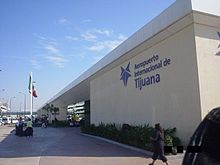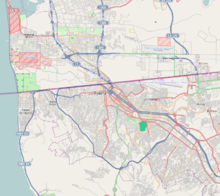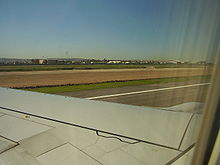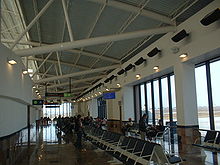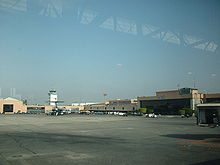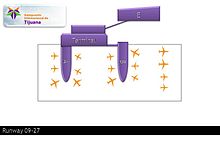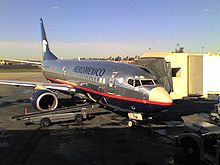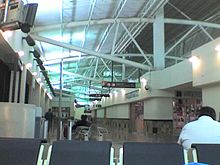- Tijuana International Airport
-
"TIJ" redirects here. For the movie, see The Italian Job. For the metalcore band, see Texas in July.
Tijuana International Airport
General Abelardo L. Rodríguez International AirportView of Main Terminal IATA: TIJ – ICAO: MMTJ Summary Airport type Public, Military Operator Grupo Aeroportuario del Pacifico Serves Tijuana-San Diego Location Tijuana, Baja California Hub for Volaris Elevation AMSL 149 m / 489 ft Coordinates 32°32′27″N 116°58′12″W / 32.54083°N 116.97°WCoordinates: 32°32′27″N 116°58′12″W / 32.54083°N 116.97°W Website Map Location within Tijuana Runways Direction Length Surface m ft 09/27 2,960 9,711 Asphalt 10/282,000 6,561 Asphalt(Closed)Statistics (2010) Total Passengers 3,649,500 Source: Grupo Aeroportuario del Pacífico Tijuana International Airport (IATA: TIJ, ICAO: MMTJ), sometimes referred to as General Abelardo L. Rodríguez International Airport, in Tijuana, Baja California, Mexico, is Mexico's second northernmost airport after Mexicali International Airport. In 2010, Tijuana International Airport handled 3,649,500 passengers, representing a 7.1% increase from 2009; as former low cost carrier operator Avolar based in Tijuana suspended operations due to financial difficulties. It is the fifth busiest airport in Mexico after Mexico City, Cancun, Guadalajara and Monterrey airports. The airport can handle up to 10 million passengers per year and 360 flights per day.
The airport serves as focus city for Aeroméxico (together with Aeroméxico Connect), the leading airline in Tijuana, which operates up to 20 daily flights to/from 15 Mexican cities. Aeroméxico is trying to develop the airport as a gateway to Asia. Since the first flight in November 2006, Aeroméxico operates 3 weekly flights to Tokyo-Narita.[1] Aeroméxico resumed services to Shanghai on March 26, 2010 after the airline halted service 11 months earlier due to the Swine flu outbreak.[2] However, the airline will temporarily suspend service to Shanghai from September 4, 2011 to January 10, 2012. The airport serves as hub for Volaris, currently the second leading airline at TIJ, and the only one operating at both concourses. It formerly was a focus city for Aero California, Aerolíneas Internacionales, Líneas Aéreas Azteca, and ALMA de Mexico. Tijuana's airport was the largest and main hub for Avolar, a new low-cost airline (since August 2005), and the airport's second leading airline at a time. It was the first low-cost airline in Mexico, before some airlines as Interjet and Volaris.
It is part of the Grupo Aeroportuario del Pacífico, a holding group that controls 12 international airports in central and northern Mexico.
Contents
History
The airport opened in 1958, replacing Tijuana's former airport, then located on today's Aguacaliente Boulevard. The new airport's first terminal was built on the southwest part of the airport, facing the new and current terminal building. The airport was incorporated to ASA in 1965.
By the end of the 60's, the demand of flights to the then-developing city of Tijuana increased, as more passengers were arriving and settling in the city. The construction of the new terminal began and was opened on October 15, 1970, by then-President Gustavo Diaz Ordaz.
The original terminal was then assigned as an air base for the Mexican Armed Forces, and it is now simply known as the aeropuerto viejo, or old airport. The terminal, however, is seldom referred as Terminal 1, with Main Terminal being referred as Terminal 2.
The airport is named after General Abelardo L. Rodríguez, Governor of Baja California, and late President of Mexico.
Expansion
The airport terminal was expanded and renovated in 2002, when the extension of concourse A and B was built, allowing the terminal to double its capacity. Several taxiways were also expanded, to allow the operations of larger aircraft such as the Boeing 747. Nevertheless, as the airport has become one of the most important hubs and gateways in the country, and the only international gateway from Asia to Latinamerica, there is a plan of a new terminal, which could house the operations of the major airline at the airport: Aeroméxico (including Aeroméxico Connect). As of today, both of the concourses have been expanded and remodeled, including the progressive introduction of glass-jetways replacing the old ones.
The airport's main terminal is currently undergoing major renovations at Concourse A and B, including new customs facilities, demolition and construction of a new bus terminal, and other exterior renovations.
Binational Terminal
In 2008, authorities from both Mexico and the United States launched Project Smart Border 2010,[3] in which among other things, it was expressed the intention for building an alternate U.S.-Mexico terminal that would relieve the high congestion at San Diego International Airport.[4] The project consists of terminal building built on U.S. soil, immediate to the border, with parking, check-in counters, and customs offices that would be linked via a bridge crossing the border to the Tijuana airport. Property on the U.S. side of the border has already been secured for this project and Secretary of State Hillary Clinton has provided approval for the project, allowing the project to move forward with an expected completion date as early as late 2012.[5]
Location
Runway 09/27 runs east-west approximately 300 meters south of the U.S.-Mexico border. The approach to the runway is either from the east (normally) or from the west (when Santa Ana wind conditions exist).
Brown Field Municipal Airport (SDM/KSDM) in San Diego, California lies just over one nautical mile (about 2 km) north of TIJ, with a similar runway length and orientation. However SDM is a general aviation field not set up for scheduled passenger service. Both SDM and TIJ are designated ports of entry.
Facilities
Commercially speaking, the airport is composed of a single runway, a parallel taxiway, and a 23 gate main terminal with two concourses, a food court and a high-tech control tower, one of the tallest in Mexico. At the opposite side of the Main Terminal building there is another terminal, the Old Airport Terminal, which houses military aviation, mostly performed by the Mexican Armed Forces. The airport is also used to a lesser extent for general aviation, housed at the General Aviation Building (GAB Terminal).
Main Terminal:
- Number of gates: 23
- Contact positions: 12
- Remote positions: 4
- Number of jetways: 10
- Number of baggage claiming carousels: 4
- Lounges:
- Aeroméxico Salón Premier (Concourse A - Floor Level)
- VIP Room Tijuana (Main Terminal - Upper Level)
- Food court (Concourses A, B - Floor & Upper Level)
- Customs (Arrivals area)
- Taxi & car rentals (Arrivals & Departures area)
- Buses (Arrivals & Departures area)
- Duty Free (Main corridor, Concourses A, B)
- Parking area (Building E)
GAB Terminal:
- General aviation apron
- VIP Room
- Pilots lounge
- Passengers lounge
Old Airport Terminal
- Apron
- Contact positions: 2
- Helipads: 2
- Parking area
Terminals, airlines and destinations
Airlines Destinations Concourse Aéreo Calafia Loreto A Aeroméxico Guadalajara, León/El Bajío, Morelia, Mexico City, Shanghai-Pudong [resumes January 10], Tokyo-Narita A Aeroméxico Connect Chihuahua, Ciudad Juárez, Ciudad Obregón, Culiacán, Durango, Guadalajara, Hermosillo, Mexico City, Monterrey A Interjet Guadalajara, Mexico City A VivaAerobus Culiacán B Volaris Acapulco, Aguascalientes, Cancún, Cuernavaca, Culiacán, Guadalajara, Hermosillo, La Paz, León/El Bajío, Los Mochis, Mazatlán, Mexico City, Monterrey, Morelia, Oaxaca, Puebla, Puerto Vallarta/Riviera Nayarit, San José del Cabo, Toluca, Uruapan, Zacatecas A & B Charter airlines
Airlines Destinations FlyMex operated by FlyAmigo Colima Global Air (Mexico) Puerto Peñasco Cargo airlines
Airlines Destinations Ameriflight Ontario Estafeta Culiacán, Hermosillo TSM Hermosillo, Queretaro Old Airport Terminal
Further information: Mexican Air Force#StructureThe Old Airport Terminal (known for locals as Aeropuerto Viejo, old airport) is set for aviation of the Mexican Military and federal police forces. This military airbase belongs to the Northwestern Region of the Mexican Air Force. One cargo airline operates at the terminal.
In-coming flights of this armed forces agencies usually arrive from the Mexican Air Force Central Region, mostly from Mexico City International Airport or nearby airbases.
GAB Terminal
Note: The General Aviation Building (GAB Terminal) is used for general/non-commercial aviation or private jets. The General Aviation Building is designed to receive up to 120 persons per hour and it has all the services for the convenience of passengers during their private flights. It has a surface of 420 sq. mts. [4,700 sq. ft.], where there are government offices, administrative offices, a pilots lounge and passenger lounge. Two aviation schools are based at this terminal, along with one cargo airline operating there.
Traffic statistics
Busiest Domestic Routes out of Tijuana International Airport (2010) [6] Rank City Passengers 1  Guadalajara, Jalisco
Guadalajara, Jalisco435,235 2  México, D.F
México, D.F405,297 3  Culiacán, Sinaloa
Culiacán, Sinaloa134,099 4  Toluca, Estado de Mexico
Toluca, Estado de Mexico111,411 5  Hermosillo, Sonora
Hermosillo, Sonora73,958 6  León, Guanajuato
León, Guanajuato71,953 7  Morelia, Michoacan
Morelia, Michoacan69,741 8  Monterrey, Nuevo León
Monterrey, Nuevo León65,872 9  Uruapan, Michoacan
Uruapan, Michoacan43,688 10  Puebla, Puebla
Puebla, Puebla43,051 11  La Paz, Baja California Sur
La Paz, Baja California Sur39,270 12  Zacatecas, Zacatecas
Zacatecas, Zacatecas35,091 13  Aguascalientes, Aguascalientes
Aguascalientes, Aguascalientes29,708 14  Acapulco, Guerrero
Acapulco, Guerrero24,691 15  Oaxaca, Oaxaca
Oaxaca, Oaxaca23,445 Ground transportation
Further information: Tijuana#Local_transportationBus
The airport may be reached from Downtown Tijuana or Zona Rio by local bus. It costs $11.00 MXP ($0.95 USD).
Shuttle
Aeroméxico provides a shuttle service from San Diego, California, United States[7] to General Abelardo L. Rodríguez International Airport to allow San Diego residents make connections within Mexico, Japan,[1] while Volaris provides a shuttle service between the airport and San Diego International Airport to allow passengers travelling either to Mexico or the United States reach their final destination.
Taxi
Due to a prohibition by Mexican law, Mexican cities' public taxis may only drop passengers to the airport, but cannot pick up passengers from the terminal. The airport thus offers transportation for passengers from the terminal to any point of the city on the SAAT Taxis (Servicio Aeroportuario de Autotransporte Terrestre, Spanish for Terrestrial Transport Airport Service, an airport government-leased taxi company). This and other authorized taxi carriers may be reached at the arrivals hall.
Incidents and accidents
- Aeroméxico Flight 498: On August 31, 1986 an Aeroméxico DC-9 that originated from Mexico City and stopped at Tijuana and other Mexican destinations collided with a private aircraft while attempting to land at Los Angeles International Airport.
- TAESA Flight 725: On November 9, 1999, covering the Tijuana – Mexico City route, with a stop in Uruapan, Michoacán, a McDonnell Douglas DC-9-31 went down a few minutes after leaving Uruapan International Airport en-route to Mexico City. 18 people were killed in the accident, which prompted inquiries regarding the airline's safety and maintenance procedures, and led to the collapse of the airline months later.
- Northwest Aeronautical Institute: On November 16, 2009, whilst developing a training flight, a Piper Cherokee suffered a sudden stop on its engine, forcing the pilot to make an emergency landing at the airport in Tijuana. Maneuvered the aircraft and landed safely at the airport but the plane sufered some damage. The operations were canceled for about an hour in the General Aviation Terminal of the airport. The two people aboard escaped unhurt, with only some scratches.[8]
- Aeroméxico: On January 21, 2010, an Aeroméxico Connect struggled to land in difficult weather conditions. After circling the airport, the plane finally landed and jumped. Passengers were told to get into the brace position. The plane skidded off the runway, and ended up with a wing buried in the mud. No injuries were reported.
Gallery
See also
- List of the busiest airports in Mexico
- Transportation in Tijuana
- San Diego International Airport
References
- ^ a b "Narita (NRT) Service," Aeroméxico
- ^ http://www.signonsandiego.com/news/2010/jan/12/china-lifting-ban-flights-mexico/
- ^ (Spanish) Lanzan México y EU iniciativa binacional, from El Financiero
- ^ (Spanish) Quieren en Tijuana terminal binacional, from Excelsior
- ^ "La Plaza". Los Angeles Times. http://latimesblogs.latimes.com/laplaza/2010/08/border-bridge-airport-san-diego-tijuana.html.
- ^ http://www.sct.gob.mx/transporte-y-medicina-preventiva/aeronautica-civil/estadistica/estadistica-historica-1992-2010/estadistica-mensual-operativa/
- ^ "Creating a connection," San Diego Union-Tribune
- ^ (Spanish) "Aterriza de emergencia una nave de la Escuela de Aviación". January 2009. http://el-mexicano.info/noticias/estatal/2009/01/16/aterriza-de-emergencia-una-nave-de-la-escuela-de-aviacion.aspx. Retrieved 2009-03-16.
External links
- Tijuana International Airport
- Current weather at MMTJ from NOAA
- Airport information for MMTJ at World Aero Data. Data current as of October 2006.
- Grupo Aeroportuario del Pacífico - Company which operates the airport.
- General Abelardo L. Rodríguez International Airport at Google Maps
- Off-Airport Parking and Ground Transportation
City of Tjuana History · Geography · Beaches · Boroughs · Demographics · Economy · Education · Government · Culture · Transportation · PeopleTijuana Municipality ·Tijuana metropolitan area · San Diego-Tijuana Metro · Baja California · Mexico Categories:- Airports in Baja California
- Buildings and structures in Tijuana
Wikimedia Foundation. 2010.

